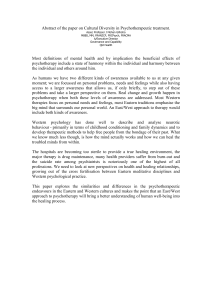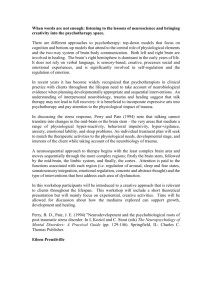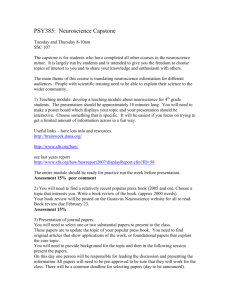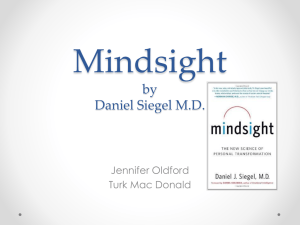An Annotated Bibliography of Contemporary Brain Research
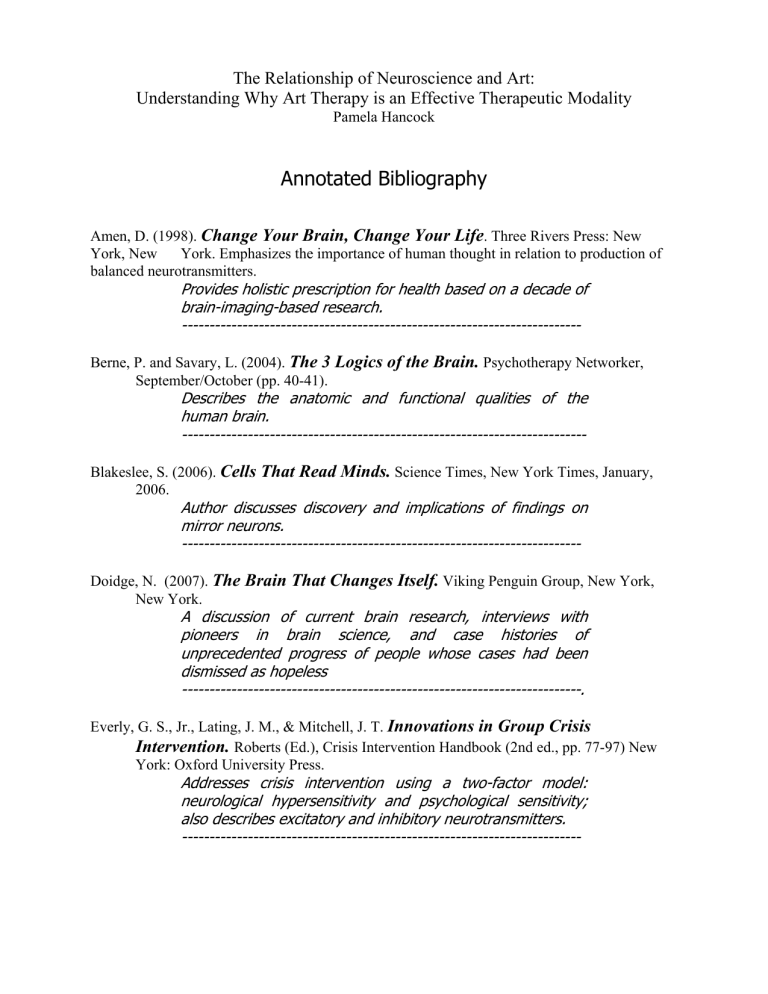
The Relationship of Neuroscience and Art:
Understanding Why Art Therapy is an Effective Therapeutic Modality
Pamela Hancock
Annotated Bibliography
Amen, D. (1998). Change Your Brain, Change Your Life . Three Rivers Press: New
York, New York. Emphasizes the importance of human thought in relation to production of balanced neurotransmitters.
Provides holistic prescription for health based on a decade of brain-imaging-based research.
-------------------------------------------------------------------------
Berne, P. and Savary, L. (2004). The 3 Logics of the Brain.
Psychotherapy Networker,
September/October (pp. 40-41).
Describes the anatomic and functional qualities of the human brain.
--------------------------------------------------------------------------
Blakeslee, S. (2006). Cells That Read Minds.
Science Times, New York Times, January,
2006.
Author discusses discovery and implications of findings on mirror neurons.
-------------------------------------------------------------------------
Doidge, N. (2007). The Brain That Changes Itself.
Viking Penguin Group, New York,
New York.
A discussion of current brain research, interviews with pioneers in brain science, and case histories of unprecedented progress of people whose cases had been dismissed as hopeless
-------------------------------------------------------------------------.
Everly, G. S., Jr., Lating, J. M., & Mitchell, J. T. Innovations in Group Crisis
Intervention. Roberts (Ed.), Crisis Intervention Handbook (2nd ed., pp. 77-97) New
York: Oxford University Press.
Addresses crisis intervention using a two-factor model: neurological hypersensitivity and psychological sensitivity; also describes excitatory and inhibitory neurotransmitters.
-------------------------------------------------------------------------
Annotated Bibliography of Neuroscience and Art Therapy 2
Felten, D. (1993 ). The Brain and the Immune System . In Healing and the Mind (pp.213-
238) New York, New York: Doubleday.
Offers a synopsis of author’s research linking neurotransmitters and the immune system
-------------------------------------------------------------------------
Fields, D. (2005). Making Memories Stick.
Scientific American, February, 2005, pp.75-81.
Outlines functions of neurotransmitters; photo credits.
-------------------------------------------------------------------------
Flannery, R., Jr. (1995). Why Are My Nerves So Frayed?: The Biology of Post-
Traumatic Stress Disorder.
In Post Traumatic Stress Disorder: The Victim's Guide to Healing and Recovery (pp. 44-61).
Describes the biological and neurological effects of traumatic stress.
--------------------------------------------------------------------------
Gladding, S. and Newsome, D. (2003 ). In Art Therapy and the Brain.
In C. Malchiodi
(Ed.), Handbook of Art Therapy (pp. 351-361). New York: The Guilford Press.
Details benefits to using art therapy, including memory retrieval
-------------------------------------------------------------------------.
Goleman, D. (2003). The Lama in the Lab. In Destructive Emotions: How Can We
Overcome Them?
(pp. 3-27) New York, New York: Bantam Dell.
Details research conducted in a brain-imaging lab with a
Tibetan monk who is a master of meditation. Unprecedented findings support the idea of neuroplasticity (our experience continually changes our brain).
-------------------------------------------------------------------------
Hannaford, C. (2005). Smart Moves (2 nd ed.). Salt Lake City: Great River Books.
Author explains the body’s role in thinking and learning from a neuroscientific viewpoint. Why movement is necessary is detailed, and how to execute integrated movement is illustrated.
-------------------------------------------------------------------------
LeDoux, J. (2002). Synaptic Self: How Our Brains Become Who We Are.
Harmondsworth, Middlesex, England: Penguin Books.
Describes how our brain (specifically, its synapses) determines how we think, act, and feel
-------------------------------------------------------------------------.
Annotated Bibliography of Neuroscience and Art Therapy 3
Lusebrink, V. (2004). Art Therapy and the Brain: An Attempt to Understand the
Underlying Processes of Art Expression in Therapy.
Art Therapy: Journal of the
American Art Therapy Association, 21(3), 125-135.
Outlines structural and functional qualities of the brain, and gives art interventions based on sensory stimulation.
-------------------------------------------------------------------------
Malchiodi, C. (2003). Art Therapy and the Brain. In C. Malchiodi (Ed.), Handbook of Art
Therapy (pp. 351-361). New York: The Guilford Press.
The author discusses the far-reaching implications of neuroscience on the field of art therapy, and includes art interventions and image formation.
McNamee, C. (2004). Using Both Sides of the Brain: Experiences that Integrate Art and Talk Therapy Through Scribble Drawings . Art Therapy: Journal of the
American Art Therapy Association, 21(3), 136-142.
Describes art interventions which link art and talk therapy using scribble drawings
-------------------------------------------------------------------------.
Miller, E. (1997 ). The Healing Image.
In Deep Healing: The Essence of Mind-Body
Medicine. United Kingdom: Hay House.
Emphasizes the power of images to heal
-------------------------------------------------------------------------.
Miller, E. (1997). The Magic of Mental Imagery: Rewriting Your Own Life Script.
In
Deep Healing: The Essence of Mind-Body Medicine. United Kingdom: Hay House.
Details the importance of self-image, world view, and relationship patterns on our mental health
-------------------------------------------------------------------------.
Miller, E. (2004). Emmett Miller MD:
Message posted to
News and Free Library.
http://www.drmiller.com/news_library/book.html
-------------------------------------------------------------------------
Moyers, B. (1993). Healing and the Mind.
New York, New York: Doubleday.
Moyers compiles the research he originally did for a PBS television series that explores connections between the mind and body. Numerous color plates add to the intrigue of the book
-------------------------------------------------------------------------.
Annotated Bibliography of Neuroscience and Art Therapy 4
Pert, C. (1993). The Chemical Communicators . In Healing and the Mind, (pp.177-194)
New York, New York: Doubleday.
Details Pert’s lifelong search for biochemical links between mind and body
-------------------------------------------------------------------------.
Sapolsky, R. M. (1996). Why Stress is Bad for Your Brain.
Science.
Retrieved April 18,
2004, from Stanford University News Service: http://www.stanford.edu/dept/news/relaged/960814shrnkgbrain.html
Details neural substrate damage and reduced hippocampal volume occurring in individuals suffering from sustained stress.
--------------------------------------------------------------------------
Sapolsky, R. M. (1998). Why Zebras Don't Get Ulcers: An Updated Guide to Stress,
Stress-Related Diseases, and Coping.
New York: W. H. Freeman and Company.
(Original work published 1994).
Discusses the effects of stress on memory, immune system, emotions, and pain tolerance. Details mind-body coping strategies
--------------------------------------------------------------------------
Siegel, D. (1999 ). In Mindsight.
Psychotherapy Networker, September/October (pp.29-39).
Reviews the integration of attachment theory, neuroscience, and psychotherapy.
--------------------------------------------------------------------------
Wylie, M. (2004). In Mindsight . Psychotherapy Networker, September/October (pp.29-39).
Reviews Daniel Siegel’s integration of attachment theory, neuroscience, and psychotherapy.
--------------------------------------------------------------------------
